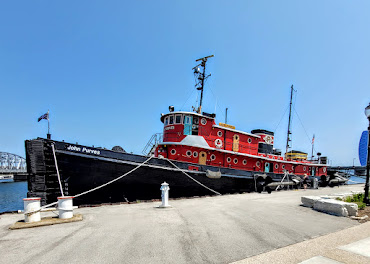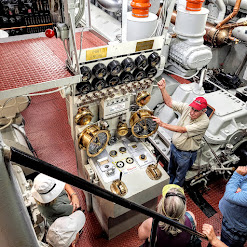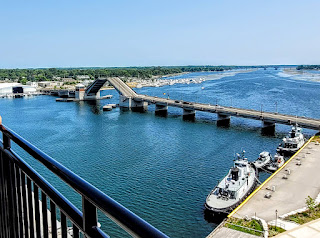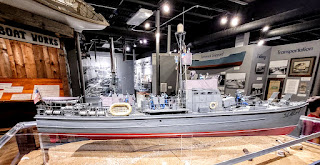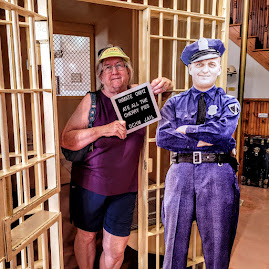The drive up to Sturgeon Bay was an easy one. Surgeon Bay is located in Door County, which is supposedly known for several things, one of which is cherries.
The campground we stayed at was not one we will stay at again, for an extended length of time. With that said, we intended to make every effort to enjoy the area.
The first place we hit was a roadhouse just up the street from the campground. This place was the typical dive bar, only it was in a building from the mid-1800s. They served some local beers, as well as the usuals, and their food, basic as it was, was very good. Carol and I both had burgers. The beef was raised by a farm a couple miles from the bar. I want to give you an idea how small this town is...
One of the days we took a drive to visit a couple of lighthouses near by. It was kind of funning getting to one of the lighthouse, visitors have to walk a narrow path to the lighthouse; one side line was painted with "Do Not Cross, Coast Guard Property", the opposite side line was painted with "Private Property".
This lighthouse is actually on the Coast Guard property, which meant there was no way to visit it, so we walked out to the other one.
The second lighthouse is a short walk down a pier, which is where the previous photo was taken.
The only access to the red lighthouse is the overhead catwalk, which is not accessible by the public.
This area is filled with lighthouses, so we will probably see a few more. This day was only the two, after which lunch loomed in our future. After unsuccessfully looking for two restaurants, we ended up a the roadhouse close to the RV campground.
Another day we drove into downtown Sturgeon Bay and visited the Door County Maritime Museum (https://dcmm.org)This museum is a two-part museum, the building and a tug boat. Timing was right for us to start with the tour of the tug.The tug is now known as the "Tug John Purves", but it started out as the "Butterfield". It was commissioned in 1919 by the U.S. Shipping Board to be used as an ocean-going tug. This tug was steel-hulled, single screw (propeller), steam powered. It's first assignment was to the Bermuda Bunkering Co., as an ocean going salvage tug. One of its remarkable traits was the ability to communicate with her throughout its 4,000 mile steaming radius; this was accomplished through her powerful radio.
1922 rolls around and Newaygo Tug Line acquires her for work on the Great Lakes. 1937 saw another change of hands, this time to the Consolidated Water Power & Paper Company of Wisconsin (CWP&PCW). CWP&PCW used the tug to tow rafts of pulpwood on Lake Superior.
During WWII, the Army called the tug back into service, designating her LT-125 Butterfield. The Army used her between 1942 and 1945 to supply the troops in the Aleutian Islands. After the war, the tug was returned to its previous owner.
In 1956, the Roen Steamship Company acquired the Butterfield. This acquisition did not not come cheap to the Roen group, it cost them $175,000, and one of their tugs, the John Roen III. Another part of the agreement for procurement, Consolidated would pay to convert the tug from steam to diesel. That upgrade consisted of two 900 h.p., 12 cylinder diesel engines, twin screws, and new auxiliaries.
Thanks to the Roen Company, they generously donated the tug to the museum, and the public has the opportunity to see life on a lake-going tug boat... so here we go.Here we are standing at the back of the boat... no, that is not Carol or I, but two other tour visitors.
Before we head inside lets discuss the name of the tug. If you remember from earlier, Roen Co. acquired the tug as the Butterfield, John Roen chose to change the name to John Purves. John Purves was invaluable to Mr. Roen. Mr. Purves was responsible for day-to-day operations of the three tugs, and five barges, finding people to load and unload the barges, traveled quite a bit soliciting work, maintaining good business relations with clients, and overseeing of goods. All this allowed Captain Roen to do what he liked best... sail the lakes, captaining one of his tugs. Mr. Roen understood very well what John Purves did for him, and acknowledged it by naming this tug for his services and loyalties to the company.
Inward we go.
What you see here is the control station and cable winch for towing barges. The cable is marked, which depended on what the barge was carrying, and which lake they were on.
From the winch room we moved down to the engineroom. Again, the engineroom looks different from its original blueprint.
This was our Docent at the engine control board. What I thought was intriguing was the fact that most of the equipment was the same stuff I worked on in the Navy. These tugs were unique, they had three fresh water systems. I found it interesting that the potable water was divided into drinking, and non-drinking. See that handle over the right side of the sink, that was the fresh water for drinking, the water to the sink was for washing hands. Not everyone got the special fresh water, only the privileged... in other words, the officers.
Up the ladder at the other end of the engineroom, we head to the berthing spaces. These tugs had a crew of about 13 people.
These are the staterooms for the officers, we were not able to go into the working crew berthing, which is forward, and below the galley/dining. From the gallery and berthing deck, we climbed the ladder to the pilot house, which was the last stop on the tour.
After the tug tour, it was time to visit the museum. I like their design for the museum, it is similar to a lighthouse (in the first museum photo, it is the tower with red squares). The tower is 10 stories, with a viewing deck.
While we were on the observation deck, we got to see the draw bridges in action.
The bridges are low enough that they need to be raised for sail boats with high masts. The lower photos show a tug pushing a barge with large Catapillar shovels.
This is a view looking down on the John Purves.
Each floor of the museum has displays specific to one idea. The 10th floor displayed the creation of the Great Lakes area, 9th floor is the indigenous people of the area. Down a few more floors is a display of ships that operate on the lakes;
down farther is the fish of the Great Lakes. The fish floor also talks about creatures that have become a burden to the natural ecosystem.
After making our way down the tower museum, we ventured into the two additional exhibit rooms. One room talks about how John Roen was the only shipyard willing to raise a lost ship in Lake Michigan. Continuing around this exhibit area visitors are surrounded by engines used on a variety of boats.
Moving over to the other exhibit room, we found the story of shipbuilding in the Sturgeon Bay during WWII.
The last photo is an older minesweeper. I mention this because... when I was in the gulf, I was in charge of conducting repairs on these boats.
Off to lunch.
After lunch we headed to the Door County History Museum (https://doorcountymuseum.org). The building looks small from the outside, but once visitors get inside, its a different world.ENTRY TO THE MUSEUM
On the right side of the lobby area is an outstanding nature display.
The gentleman that made this display was a taxidermist, and it took him close to 20 years to complete it. Initially the display was available to visitors, he just continued to add to it. There are over a hundred birds represented in the exhibit.
The first room we visited after the lobby was a tribute to fire and police of the past.Carol is riding high in one of the three fire engines. This particular one is a 1920 Oldsmobile, and actually had chemical tanks on the back. The original cost in 1920 was $1,465.00. It was in service until 1951, and retired. In 1976 it was purchased by the Pioneer Fire Company for $11,000.00
The other two fire trucks were for display only, not climbing on.
Carol and I are not afraid to raise a little hate and discontent, but we didn't realize how strict the police were...BUSTED FOR EATING ALL THE CHERRY PIES
RANG THE BELL TOO MANY TIMES
One last fire truck before we move on...In 1869, a local carpenter built this wooden tank, and lined it with steel. It was mounted on running gear (wheels), a pump added, and 100 feet of donated fire hose from the local sawmill. It was still necessary to have a bucket brigade to keep the tank filled. The advantage to the pumper was its ability to shoot a one inch stream further than a fireman could toss a bucket of water.
Two people from Sturgeon Bay enlisted in the Navy, at different times, became a couple.
The upper floor was dedicated to people that lived in the area. Leonard Potier joined the Navy right out of high school, and after boot camp and "A" school, was stationed in Pearl Harbor. Surviving Pearl Harbor, he transferred to a ship in San Diego. Ruth Schmetzer graduated from the same high school, a few years later, and followed in her brothers' footstep, joining the WAVES (Navy). Leonard sustained a work related injury during his enlistment, and was honorably discharged. After his discharge he and Ruth corresponded with each other, eventually getting married. Ruth had to get permission from her commanding officer to wear a wedding dress for her wedding. Ruth was still active service, and was station overseas in Europe. When the Germans surrendered she requested, and received her discharge from service.
Here we have two chiefs from the Oshkosh family of the Menominee tribe. Roy (color photo) took over the Chief position when his father died in 1939. He was honored by the Boy Scouts, and the governor of the state. In 1971 he was named "Door County's #1 Ambassador" by the governor. Roy passed in 1974.
Another portion of the upper floor celebrated the Fish Boil of Door County. This celebration still happens, only not at the original restaurant. The "boil" meal consists of steamed potatoes and white fish, with a slice of Door County cherry pie.
Moving down to the bottom floor, were exhibits of life in Door County...Imagine yourself living with the wooden prosthetic, this one came from Poland.Can you guess what this is? It is a mechanical chicken plucker.
They did not let winter stop the evolution of life and death back in the day...This hearse, from 1918, was used in the winter when motorized vehicles were not feasible. The horses would have been draped with black blankets, and the teamsters would have worn black fur coats. Unfortunately, while in storage in 1940, the hearse was destroyed by fire.
Our next stop in town was trouble... it was the Door County Chocolate Store. We did spend some money here. With this victory we headed home for the day, to prep for a new adventure.
One cannot visit Door County without finding something cherry to buy, and we were no different.What you don't see are the wines we picked up too. Country Ovens brand is "Cherry De-Lite". Did I mention the chocolate covered cherries we bought too. This was just one of the stores we visited that day, the other was Grandma Tommy's Country Store...This was not a small mom and pop store. They had everything from brats to ice cream, with alcohol and cheese in between. For those not interested in food, they had all kinds of souvenirs.
What is Wisconsin if there was no cheese? We answered the call and headed to an artisan cheese shop, with a bistro...
This place had more than cheese, and I think we bought a good share of it. These folks were very gracious with cheese samples, as well as samples of their balsamic vinegars and oils.
Here are a few samples..
As one might see, we found our favorites, a pomegranate balsamic, and Bordeaux cherry balsamic; we don't use a lot of olive oils.
The bistro had some interesting selections, and one of them caught our eyes for sure. Before we get to that treat, lets look at something Carol nor I have ever seen before. For beer and wine lovers, you have probably ordered a flight of beer or wine for sampling, but what about...a flight of ice cream. They have a dozen flavors visitors can choose from, and sell by the pint, half gallon, or gallon. one of our samples didn't really have a name, probably because it was a kitchen sink kinda recipe... and very good.
Back to the treat that caught our eyes. This bistro does melts, you know, things like patty melts and grilled cheese sandwiches. I present to you the Door County Cherry Melt..."This is a sweetened cream cheese and sour dough sandwich dipped in French toast batter, grilled, then topped with Door County cherries, toasted almonds, and whip cream." What you are looking at is only half the sandwich... we shared one. The sandwich was very rich and delicious; neither one of us could have eaten a whole sandwich. The sandwich we took home to try, it would have been too much to eat it at the bistro. We had the cherries put in a cup on the side for travel."
Our next journey will take us further into Door County, but that will be in the next installment, so we will see you then.









